Gtchavank Monastery – A Karabakh Gem Marred by Graffiti
Viktor, Seko and others have left their mark on church walls. Will today's visitors be as disrespectful? 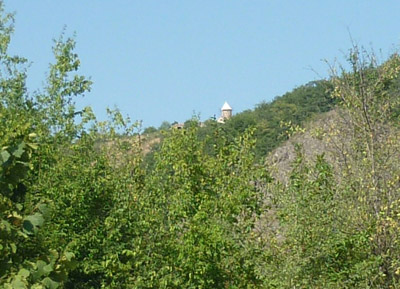 The Gtchavank monastery complex high up in the distance.
The Gtchavank monastery complex high up in the distance.
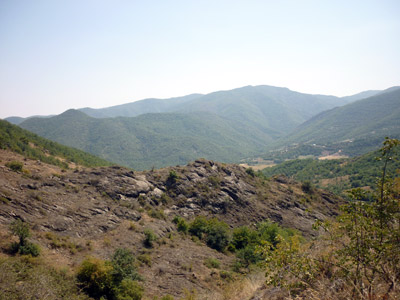 To get to Gtchavank, in the proximity of the village of Togh, one has to make a long trek over cliffs in a thick forest. The monastery has a long history as a seat of the local bishopric and is noted in historical documents as early as the 5th century.
To get to Gtchavank, in the proximity of the village of Togh, one has to make a long trek over cliffs in a thick forest. The monastery has a long history as a seat of the local bishopric and is noted in historical documents as early as the 5th century. 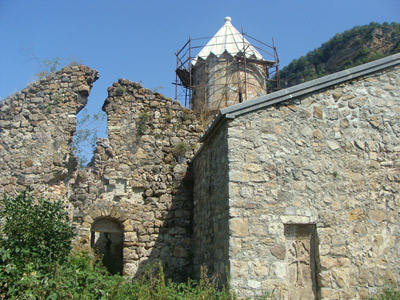 According to historian Lernik Hovhannisyan, “The religious fathers of Gtchavank participated at the Council of Partav (709 AD), convened to discuss the matter of the Catholicos of Aghvank, Nerses Bakour, who was following the teachings of Chalcedon. Movses Kaghankatvatsi records the site as being a diocesan seat of the church. It served as the seat of the Dizak princedoms and later a center of spiritual worship. The complex served as a center of regional enlightenment, housing a library, school and manuscript repository. Gtchavank played a prominent role in the development of the Armenian people’s cultural and religious history.”
According to historian Lernik Hovhannisyan, “The religious fathers of Gtchavank participated at the Council of Partav (709 AD), convened to discuss the matter of the Catholicos of Aghvank, Nerses Bakour, who was following the teachings of Chalcedon. Movses Kaghankatvatsi records the site as being a diocesan seat of the church. It served as the seat of the Dizak princedoms and later a center of spiritual worship. The complex served as a center of regional enlightenment, housing a library, school and manuscript repository. Gtchavank played a prominent role in the development of the Armenian people’s cultural and religious history.” 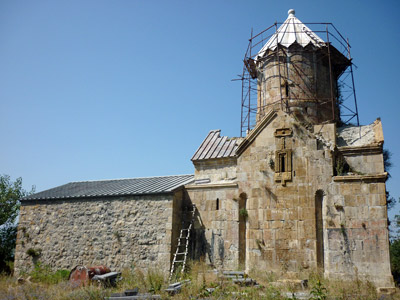 A large inscription on the present church's northern wall states that two brothers, episcops’ Ter Sargis and Ter Vrdanes, migrated here from Amaras, and built the main church of Gtchavank. The building was founded in 1241 and was finished in 1246. There are stone crosses on the site that date much earlier. One of the crosses was exhibited in France for the “Armenian Cultural Days” program. In the 1930’s, a stone cross from Gtchavank was transported to Etchmiadzin were it now proudly takes its place alongside other exquisite examples of Armenian religious stone carvings.
A large inscription on the present church's northern wall states that two brothers, episcops’ Ter Sargis and Ter Vrdanes, migrated here from Amaras, and built the main church of Gtchavank. The building was founded in 1241 and was finished in 1246. There are stone crosses on the site that date much earlier. One of the crosses was exhibited in France for the “Armenian Cultural Days” program. In the 1930’s, a stone cross from Gtchavank was transported to Etchmiadzin were it now proudly takes its place alongside other exquisite examples of Armenian religious stone carvings. 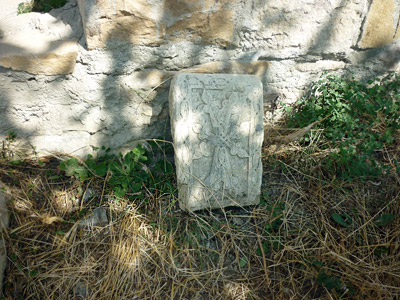 Sadly, the buildings are almost completely defaced by graffiti. Over the years, visitors have felt compelled to inscribe their names, mostly in a foreign language, Russian but also in Armenian, as a reminder of their presence here. The graffiti dates back as early as the 1930’s up till the early 1980’s. The names of the infamous include Viktor, Seko and many others long gone.
Sadly, the buildings are almost completely defaced by graffiti. Over the years, visitors have felt compelled to inscribe their names, mostly in a foreign language, Russian but also in Armenian, as a reminder of their presence here. The graffiti dates back as early as the 1930’s up till the early 1980’s. The names of the infamous include Viktor, Seko and many others long gone. 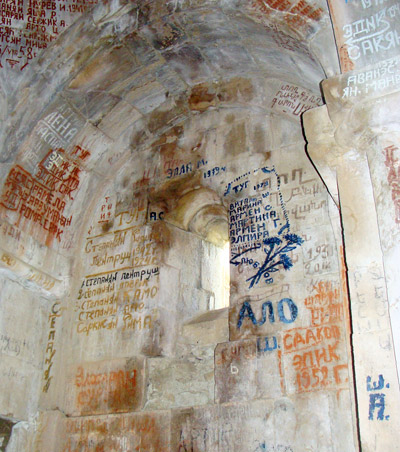 Some heartless visitors have even painted their monikers on the ceiling of the main church.
Some heartless visitors have even painted their monikers on the ceiling of the main church. 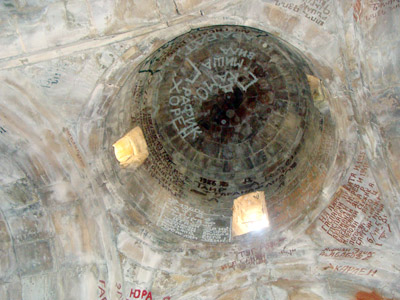 The floor of the church is in ruins. There are many cracked tombstones to be found inside. Candles are lit on the church altar.
The floor of the church is in ruins. There are many cracked tombstones to be found inside. Candles are lit on the church altar. 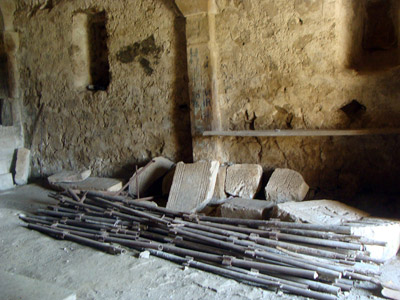 “Candles are even lit on the stone crosses, which is prohibited. People also make sacrifices in the church and hang the severed heads of various animals here and there. This too is not allowed. There are churches that are being used as stables. The same is true in the RoA,” says Lernik Hovhannisyan.
“Candles are even lit on the stone crosses, which is prohibited. People also make sacrifices in the church and hang the severed heads of various animals here and there. This too is not allowed. There are churches that are being used as stables. The same is true in the RoA,” says Lernik Hovhannisyan. 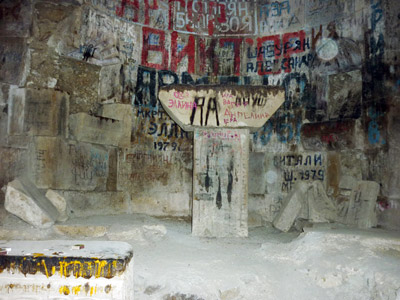 The church escaped unscathed during the Artsakh liberation war. It was singled out for misuse during the Soviet era. Artziv Lalayan, who heads the Khanperyants Museum in the village of Metz Taghlar, states that it was Armenians who defaced the walls of the church; not Azerbaijanis. “During the Soviet period, people did anything they wished and got away with it. There were no guards here to watch over the place. Maybe Turks also despoiled the church, but there was a certain fear in most of them. Usually, they didn’t do such things unless the state specifically dispatched them to dynamite monuments and carry out other acts of vandalism.”
The church escaped unscathed during the Artsakh liberation war. It was singled out for misuse during the Soviet era. Artziv Lalayan, who heads the Khanperyants Museum in the village of Metz Taghlar, states that it was Armenians who defaced the walls of the church; not Azerbaijanis. “During the Soviet period, people did anything they wished and got away with it. There were no guards here to watch over the place. Maybe Turks also despoiled the church, but there was a certain fear in most of them. Usually, they didn’t do such things unless the state specifically dispatched them to dynamite monuments and carry out other acts of vandalism.” 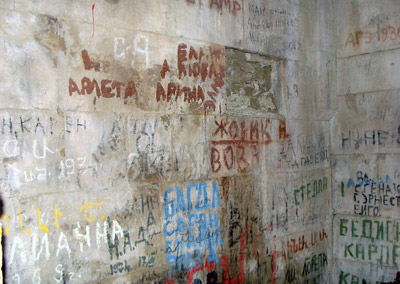 Sergey Shahverdyan, who heads the NKR Department of Tourism, told Hetq that the government has been conducting renovation work at Gtchavank since 2006. The rehabilitation project had temporarily stopped but will restart this October. The NKR government has allocated 30 million AMD ($81,000) for renovations in the 4th quarter of 2010.
Sergey Shahverdyan, who heads the NKR Department of Tourism, told Hetq that the government has been conducting renovation work at Gtchavank since 2006. The rehabilitation project had temporarily stopped but will restart this October. The NKR government has allocated 30 million AMD ($81,000) for renovations in the 4th quarter of 2010.  Renovation work is scheduled to continue for a few years. Mr. Shahverdyan says that the project depends on the availability of government funding.
Renovation work is scheduled to continue for a few years. Mr. Shahverdyan says that the project depends on the availability of government funding. 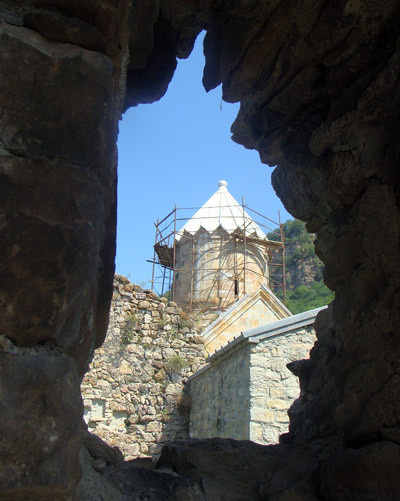 Graffiti now covering the monastery walls will also be removed. Tragically, some of the new stones used to renovate the main church have already fallen victim to graffiti. “Seeing these stones really pains me. On one, someone has written ‘Born in 1995’. These people were brought up watching Brazilian TV soap operas, right? What can you expect? Now, there is a new generation raised on Armenian TV soaps. They too can come and defile the place. That’s what they are being taught, no? At least these people just wrote their names. New visitors might even blow the place up,” says Artziv Lalayan.
Graffiti now covering the monastery walls will also be removed. Tragically, some of the new stones used to renovate the main church have already fallen victim to graffiti. “Seeing these stones really pains me. On one, someone has written ‘Born in 1995’. These people were brought up watching Brazilian TV soap operas, right? What can you expect? Now, there is a new generation raised on Armenian TV soaps. They too can come and defile the place. That’s what they are being taught, no? At least these people just wrote their names. New visitors might even blow the place up,” says Artziv Lalayan.  Sergey Shahverdyan says that while there is no guard patrolling Gtchavank today, there is a monuments’ inspector whose job it is to monitor such invaluable cultural sites. Mr. Shahverdyan says such inspectors are posted one to a valley, and not to a specific monument or geographic district.
Sergey Shahverdyan says that while there is no guard patrolling Gtchavank today, there is a monuments’ inspector whose job it is to monitor such invaluable cultural sites. Mr. Shahverdyan says such inspectors are posted one to a valley, and not to a specific monument or geographic district. 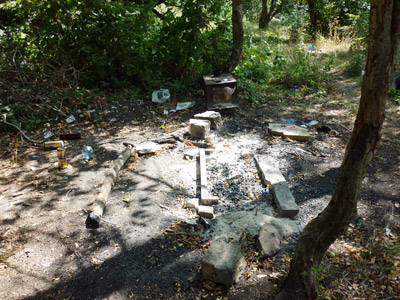 “No guard or locked door can save a monument from the ravages of damage if people do not begin to comprehend the intrinsic value of such places. In my humble opinion, the preservation of such sites isn’t solely the responsibility of the government or an inspector. Until the time when we can inculcate local residents with a respect and appreciation for our traditional cultural values, we won’t be able to preserve such monuments,” argues Mr. Shahverdyan Lernik Hovhannisyan shares this view. He points to the bottles and refuse left by picnickers on the church grounds. Nearby is a “Do Not Litter” sign.
“No guard or locked door can save a monument from the ravages of damage if people do not begin to comprehend the intrinsic value of such places. In my humble opinion, the preservation of such sites isn’t solely the responsibility of the government or an inspector. Until the time when we can inculcate local residents with a respect and appreciation for our traditional cultural values, we won’t be able to preserve such monuments,” argues Mr. Shahverdyan Lernik Hovhannisyan shares this view. He points to the bottles and refuse left by picnickers on the church grounds. Nearby is a “Do Not Litter” sign. 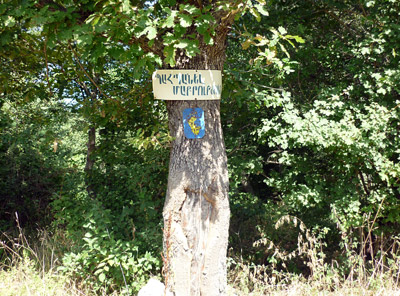
 “Sure you can post a guard, but so what? We renovate the church but soon after people visit and turn the place into a garbage dump,” says Lernik Hovhannisyan, adding that there are churches in worse shape than Gtchavank.
“Sure you can post a guard, but so what? We renovate the church but soon after people visit and turn the place into a garbage dump,” says Lernik Hovhannisyan, adding that there are churches in worse shape than Gtchavank.
 Videos
Videos Photos
Photos




Write a comment